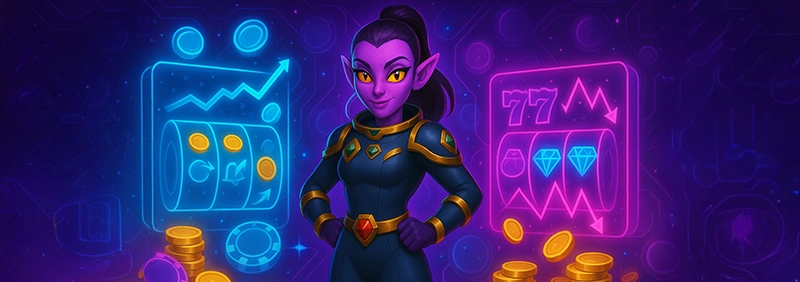Home > Casino Lab > Science of Slots > Slot Volatility Explained: High Risk vs Low Risk Games
Slot Volatility Explained: High Risk vs Low Risk Games
When players choose a slot machine, they often look at themes, graphics, or jackpot sizes. But behind every game lies a critical concept that shapes the experience: volatility. Also known as variance, volatility measures how a slot distributes its payouts over time. Understanding volatility allows players to pick games that fit their risk tolerance, bankroll, and playing style.
From low-risk slots that pay frequently but modestly to high-risk games that offer rare but massive wins, volatility is the lens through which the thrill of gambling becomes clear.

What Is Slot Volatility?
Slot volatility refers to the risk profile of a game. It does not change the RTP (Return to Player), but it influences the frequency and size of payouts.
- Low volatility slots deliver smaller wins more often, making them ideal for players who prefer consistent gameplay and extended sessions.
- High volatility slots produce fewer payouts but with higher potential, attracting risk-takers chasing big jackpots.
- Medium volatility slots balance the two extremes, offering both steady action and occasional big wins.
Volatility, therefore, is less about the overall return and more about how that return is experienced.
Why RNGs Matter for Fairness in Slots
RNGs are crucial because they guarantee fairness and unpredictability. Without them, casinos could manipulate outcomes, and players would never trust the games. With RNG algorithms:
- The probability of landing a winning combination remains consistent across spins.
- The casino cannot alter results in real time.
- Players cannot influence outcomes through strategy or superstition.
Independent regulatory bodies regularly audit RNG systems in online casinos, testing them for fairness and compliance. This external verification ensures that RNG-based slots operate within industry standards and that the published Return to Player (RTP) rates are accurate.
Why Volatility Matters for Players
Understanding volatility helps players align their strategy with their expectations. Casual players with smaller bankrolls may enjoy low volatility slots, where frequent wins keep the excitement alive without draining funds too quickly. Conversely, high volatility games are better suited for players with larger budgets and the patience to withstand long dry spells in exchange for the chance at massive payouts.
Volatility also impacts the psychological experience. Some players thrive on steady rewards that feel rewarding, while others enjoy the adrenaline rush of chasing rare jackpots. Recognizing this distinction allows players to choose games that deliver the kind of excitement they seek.
Examples of Volatility in Action
Imagine two different slots, both with an RTP of 96%. In a low volatility slot, a player might win small amounts—$5 or $10—every few spins, but jackpots rarely exceed 50x the bet. In a high volatility slot, the player could spin dozens of times without a win, only to hit a jackpot worth thousands of times the stake.
Although both games mathematically return the same percentage over the long run, the journey to that return is entirely different. This is why volatility is often considered just as important as RTP in determining player satisfaction.
How Casinos and Developers Use Volatility
Game developers design slots with specific volatility profiles to target different audiences. Casual players may be drawn to light, fast-paced games with frequent payouts, while high rollers often seek “big win” slots that test patience and bankroll management. Casinos, meanwhile, highlight volatility in game descriptions to help players make informed choices.
Some modern casinos even allow players to filter games by volatility level, acknowledging its growing role as a key factor in player decision-making.
The Future of Slot Volatility
As technology advances, volatility may become even more customizable. Some experimental games already allow players to adjust volatility settings, choosing between frequent smaller wins or rare high-risk payouts.
In Web3 environments, volatility could be encoded transparently into smart contracts, making the risk-reward structure fully verifiable on the blockchain. By 2030, volatility may not just define how slots work—it may become a feature that players actively control.
Conclusion
Slot volatility is one of the most important factors in understanding how slot machines behave. It doesn’t affect the overall RTP but dictates how wins are distributed across time—steady and modest, or rare and explosive. For players, grasping volatility is the key to choosing games that align with bankroll, strategy, and personal excitement.
The next time you spin, don’t just check the RTP—look at the volatility. It could make all the difference between a fun session and a frustrating one.
